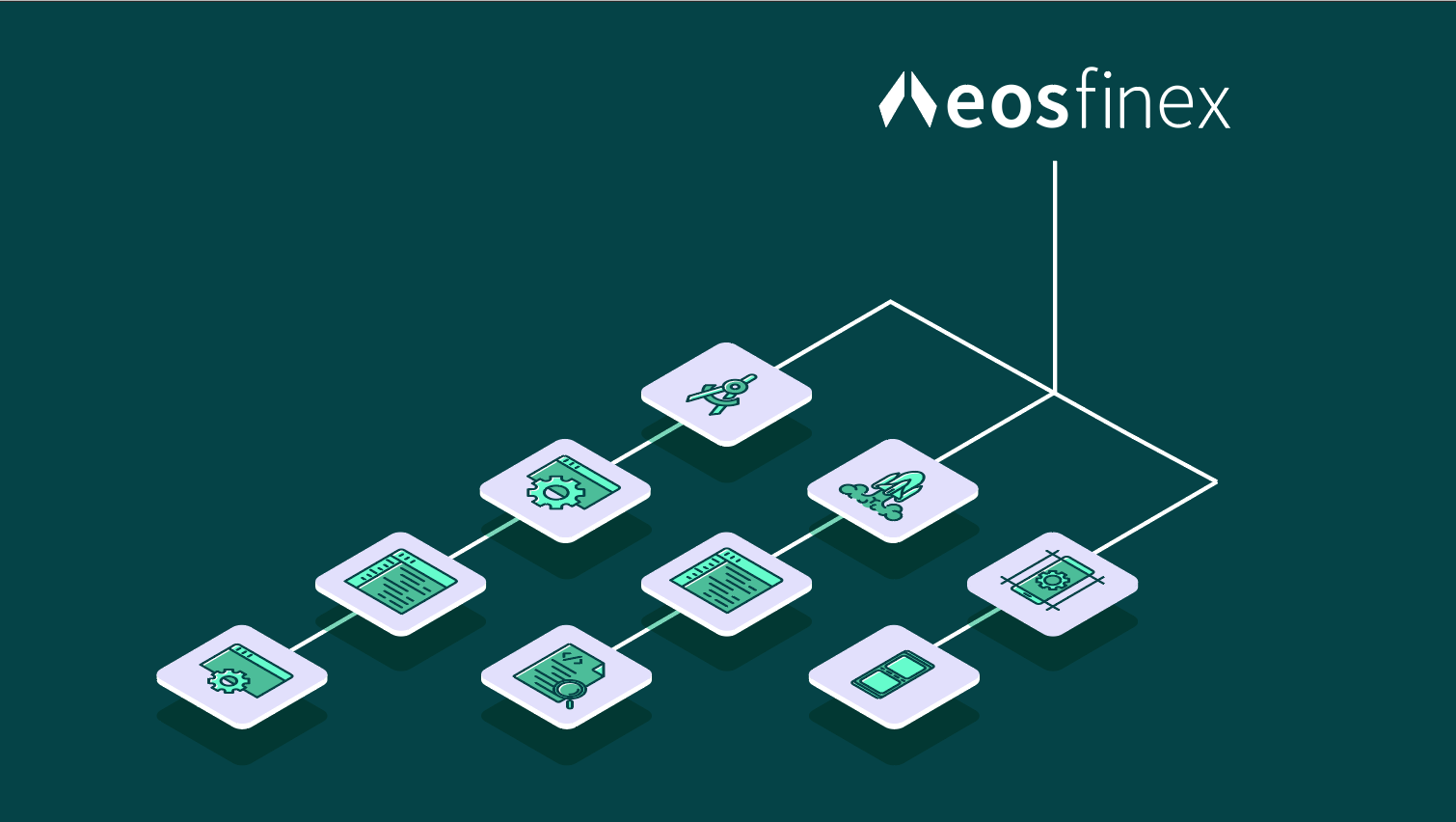
译文/Translated:
把资产交易所转变成一个透明的、面向所有人的网络,这是区块链运动核心的最根本目标之一。
相应地,区块链社区真挚地希望能够通过基于区块链的交易能力来探索金融创新。我们开发了P2P交易平台eosfinex,因此很荣幸地为这场运动添砖加瓦,通过我们的平台,所有的大额交易功能都可以在链上进行。
Eosfinex这个平台由以下几个部分构成:
1. 订单账户
2. 订单匹配
3. 结算和托管
尽管这些是交易发展的“圣杯”,但实际上把它们都搬到链上是个巨大的挑战——最主要的问题是技术上的。
本文我们将和你分享开发eosfinex过程中我们遇到的几个问题以及我们怎么通过技术创新攻克这些问题。
EOS带来的希望
技术上来说,EOS出现之前,并没有哪个框架配备必须的费用结构和性能要求来实现完全的链上交易。
通过权益委托证明机制(DPoS),使用EOS软件的网络解决了其它区块链网络会遇到的费用结构和规模化问题。然而,因为EOS把网络资源作为权益,它就可以去掉网络交易费用。此外,让区块生产者能把更多算力放在处理交易(相比,工作量证明等)上,EOS让网络能够减少区块空间,实现产出大幅提高。
所以,想把主要的交易部件放到链上,EOS就凭借这些创新成为理想的区块链。
Eosfinex建筑结构
Eosfinex是业内第一个建立在EOS软件上的完全链上、完全透明、规模化的交易生态系统。
为了实现可接受的不可逆时间和交易反应性,交易合约首先会在一个使用EOX做系统代币的侧链进行,这就自然可以根据用户拥有和当作权益的EOX数量来分配交易资源。用户要用EOX购买RAM来放置休眠eosfinex订单、把客户智能合约加载到她的侧链账户上。
这个项目会随着其基础EOS软件的发展而发展,因为eosfinex引入了异步确认(BFT-DPOS)把网络的不可逆转时间降到区区几秒,eosfinex可以增加侧链BP的数量,甚至还可以在EOS主链上发行。
用户可以直接向EOS区块链发送交易,或者通过支持常见的Bitfinex WebSockets API的用户eosfinex节点插件,这两种方式接入交易生态系统。Eosfinex插件让现有的Bitfinex或者Ethfinex用户在第一天就可以轻松地把自己的交易系统指向eosfinex。
Eosfinex费用结构的设计回馈所有提高流动性的用户,它会通过一个操作和计算都简单的交易费用扣除实现这一目的。更多的eosfinex用户就意味着更多的EOS用户,这就给更多dApp开发和真正有趣的跨合约应用打开了大门。
侧链和主链的代币交易将会通过两个网关合约实现同步,这两个网关分别在两个链上。一个可信的外部程序会调查每个网关合约分别的代币交易,然后把交易传输到其它链上。API和UI支持常见的签名机制,如Scatter和硬件钱包。这样,UI的常驻用户和做市商能够从这个最先进的证明支持中获益,这也进一步保证健康的生态系统。
Eosfinex的初始主要项目组建包括:
1. 交易合约:完全链上结算、订单账簿和匹配引擎
2. 主链关口合约:结算在侧链的代币
3. 侧链关口合约:发行和销毁侧链代币
4. 侧链网络:使用EOX系统代币
5. 节点插件:支持通过Bitfinex V2 WebSocket 合约连接
6. 用户界面:Bitfinex风格的用户界面,支持签名交易
7. API用户库:从浏览器和服务器把多态库和WebSocket关口联系起来。支持主要的EOS的身份认证机制,如Scatter和硬件钱包。
除此之外,未来eosfinex还准备发展以下项目:
1. 可能为了改进侧链性能微调EOS软件时间。
2. 增加侧链BP数和/或通过释放BFT-DPOS的EOS支持使其在EOS主网上线
3. 给eosfinex增加保证金能力
在一年的艰苦工作和挑战之后,我们很自豪地宣布将在下周向EOS社区发布eosfinex的beta版本。
这个版本会在一个“模拟交易”环境下运行。用户将在一个模拟的生态系统中尝试使用eosfinex,同时还能通过提供平台反馈获得奖励。接下来几天我们会提供漏洞通报要点,从而让用户构建其平台反馈。
我们很想看到EOS社区怎么反馈我们的beta测试版,在他们的帮助下,我们希望能在不远的未来上线完整版的软件。
要获得eosfinex beat测试账号,在这里留下您的邮箱。
本文作者是Robert Kowalski 和Jeffrey Lozier, 他们都是我们非常棒的开发者。想和我们的开发团队对话,请在点击eosfinex Telegram
在以下媒体上关注最新研发成果以及我们2019年3月的发布内容。
原文/Original:
Breaking down asset exchange to a transparent network, accessible to all, is one of the foundational goals at the heart of the blockchain movement.
In line with this, there exists a genuine desire within the community to explore financial innovation through the development of blockchain-based trading capabilities. We are proud to have contributed to this movement by developing eosfinex, a peer-to-peer trading platform upon which all major exchange functionality is on-chain.
As a platform, eosfinex is composed of the following components:
- Order books
- Order matching
- Custody and settlement
Although certainly the ‘Holy Grail’ of exchange development, implementing the above components on-chain has posed serious challenges — the main challenge being technical.
This post will share with you the hurdles we encountered in the creation of eosfinex and how, through innovative technological approaches, we were able to overcome them.
The promise of EOS
Technically there has simply not been a framework available with the necessary fee structure and performance requirements for a fully on-chain exchange until EOS.
Through the use of Delegated Proof-of-Stake (DPoS), networks adopting the EOS software address the fee structure and scalability problems seen on other blockchain networks. By instead staking for network resources, EOS allows for the removal of network transaction fees. Additionally, allowing block producers to spend more computing power on processing transactions (relative to e.g. Proof-of-Work), has enabled the network to run with reduced block-spacing and significantly higher throughput.
These innovations make EOS an ideal blockchain for bringing all major exchange components on-chain.
The eosfinex Architecture
Eosfinex is the industry’s first fully on-chain, fully transparent and scalable exchange ecosystem built on EOS software.
In order to achieve acceptable irreversibility times and exchange responsiveness, the exchange contract will initially run on a sidechain using EOX as the system token, thus providing a natural way of allocating exchange resources based on the amount of EOX a user has acquired and staked. A user will also use EOX to buy RAM for placing resting eosfinex orders and for potentially loading a custom smart contract onto her sidechain account.
The project will grow along with the EOS software it is built on. As asynchronous confirmations (BFT-DPOS) are introduced that cut network irreversibility times to mere seconds, eosfinex can increase the number of sidechain BPs and even launch on the EOS mainchain.
Customers can interface with the exchange ecosystem by sending transactions directly to the EOS blockchain, or by using a custom eosfinex nodeos plugin that supports the familiar Bitfinex WebSockets API. The eosfinex plugin makes it easy for existing Bitfinex or Ethfinex users to point their trading systems at eosfinex from day one.
The eosfinex fee structure is designed to improve liquidity by rewarding all providers of liquidity with a simple and easy to calculate trading fee rebate. More eosfinex users means more EOS users, opening up the door for more dApp development and a myriad of truly exciting cross-contract applications.
Token transfers between the sidechain and main chain will be synchronized using two gateway contracts — one on each chain. A trusted external process will poll for token transfers into each gateway contract and then forward the transfers to the other chain. The API and UI will support popular signing mechanisms like Scatter and hardware wallets. In this way, both regular UI users and market makers can profit from state of the art authentication support, which further helps to ensure a healthy ecosystem.
A summary of the initial main eosfinex project components are:
- Exchange contract: Fully on-chain custody, order book, and matching engine.
- Main chain gateway contract: Custody for tokens whilst on sidechain.
- Side chain gateway contract: Issues and burns sidechain tokens.
- Sidechain network: Uses the EOX system token.
- Nodeos plugin: Supports connecting via Bitfinex V2 WebSocket protocol.
- User Interface: Bitfinex style UI with support for signing transactions.
- API client library: Polymorphic library to interact with the WebSocket gateway from the browser and server. Supports major EOS auth mechanisms like Scatter and hardware wallets.
In addition to this, future developments on eosfinex are set to include, amongst other things:
- Possible tweaking of EOS software timings for sidechain performance improvements.
- Increasing the number of sidechain BPs and/or launching on the EOS mainnet with the release of EOS support for asynchronous block confirmations (BFT-DPOS).
- Adding margin capabilities to eosfinex.
After a year filled with challenges and hard work, we’re proud to release the eosfinex beta to the EOS community in the coming week.
The beta will operate as a ‘Paper Trade’ environment, providing our users with the chance to experiment with eosfinex in a simulated ecosystem whilst earning rewards through providing platform feedback. A bug bounty outline will be presented in the coming days upon which users can structure their platform feedback.
We’re excited to see how the EOS community interacts with the beta and with their help, look forward to launching the fully-functioning version in the near future.
For access to the eosfinex beta, leave your email here.
This article was co-authored by Robert Kowalski and Jeffrey Lozier, two of our fantastic developers. To talk to our development team, stop by the eosfinex Telegram.
Stay up to date with developments below as we approach our March 2019 launch.
- Telegram — Announcements / Discussion
原文链接/Original URL: